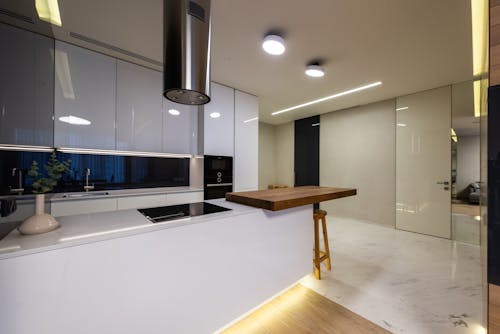There are seven elements that make up interior design: light, space, colour, line, texture and pattern, form, and furniture/objects.
Light
Light can change a room by changing the impact of other elements such as colour and texture. There are two main types of light and a few subcategories. The two types are natural and artificial. There are three types of artificial lighting: task lighting, mood lighting, and accent lighting. Task lighting applies to bedside or desktop lighting. Mood lighting refers to the ambient lighting in a space, such as a candelabra. Accent lighting refers to lighting that highlights specific aspects of the room, such as a painting or bookcase.

Space
This element of interior design refers to your room in general. The shape of the room, the height of the ceiling, number of walls, placement of windows, etc. The space can be made more interesting with alcoves, heights, and the placement of positive space and negative space (areas with objects/furniture vs. empty space, respectively).
Colour
Colour has a big impact on the feel of a room. Dark colours make a room feel small while bright colours add energy and excitement. Soft pastels are calming while browns and neutrals are safe. Colour can be used to add depth, emotion, and harmony between objects, textures, and patterns in the space.
Line
Line provides the shape and form of a room. This element is divided into three categories: dynamic lines, vertical lines, and horizontal lines. Dynamic lines add movement (staircase), vertical lines add freedom (doors and windows), and horizontal lines add stability (chairs or tables). Dynamic lines can be “hard” and add energy to a space with patterns and colour, or “soft” to tie other lines together in harmony.
Texture and Pattern
Pattern and texture add depth and interest to a room and are closely related to colour. Texture mainly refers to the fabrics used for curtains and upholstery, rugs, and blankets in the space. Smooth and shiny materials provide a sense of sophistication and formality while rougher textures relate to a cozy, welcome atmosphere.
Form
Form applies to two things: the shape of your space and objects in that space, and the shape of the lines in your space. The proportions of a room and the variety of shapes and objects affect the feel and flow of a room; circles soften the space, rectangles create flow, triangles offer stability, etc. Balance is important with this element.
Furniture and Objects
This element is mainly about the functionality of a room. Furniture also provides flow through the home by developing walkways and paths of energy through the space. Furniture can be used to highlight focal points, such as a tv or fireplace, while objects are more personal and tell a story about your life and personality.
For more tips on interior design, click here.